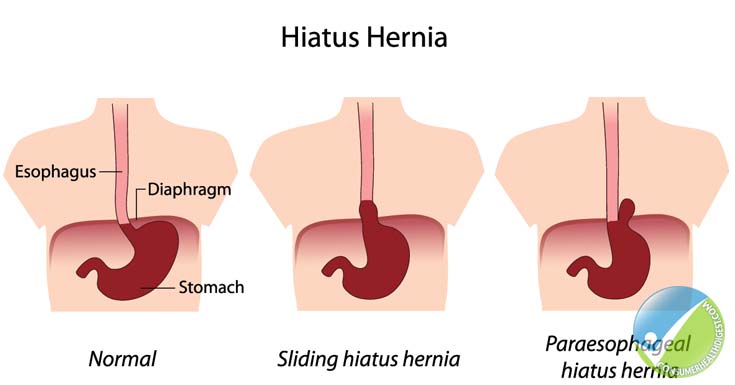Any time an internal body part pushes into an area where it doesn’t belong, it’s called a hernia.
The hiatus is an opening in the diaphragm — the muscular wall separating the chest cavity from the abdomen. Normally, the esophagus (food pipe) goes through the hiatus and attaches to the stomach. In a hiatal hernia(also called hiatus hernia) the stomach bulges up into the chest through that opening.
There are two main types of hiatal hernias: sliding and paraesophageal (next to the esophagus).

In a sliding hiatal hernia, the stomach and the section of the esophagus that joins the stomach slide up into the chest through the hiatus. This is the more common type of hernia.
The paraesophageal hernia is less common, but is more cause for concern. The esophagus and stomach stay in their normal locations, but part of the stomach squeezes through the hiatus, landing it next to the esophagus. Although you can have this type of hernia without any symptoms, the danger is that the stomach can become “strangled,” or have its blood supply shut off.
Many people with hiatal hernia have no symptoms, but others may have heartburn related to gastroesophageal reflux disease, or GERD. Although there appears to be a link, one condition does not seem to cause the other, because many people have a hiatal hernia without having GERD, and others have GERD without having a hiatal hernia.
People with heartburn may experience chest pain that can easily be confused with the pain of a heart attack. That’s why it’s so important to undergo testing and get properly diagnosed.
What Causes a Hiatal Hernia?
Most of the time, the cause is not known. A person may be born with a larger hiatal opening. Increased pressure in the abdomen such as from pregnancy, obesity, coughing, or straining during bowel movements may also play a role.
Who Is at Risk for Hiatal Hernia?
Hiatal hernias occur more often in women, people who are overweight, and people older than 50.
How Is a Hiatal Hernia Diagnosed?
A hiatal hernia can be diagnosed with a specialized X-ray (using a barium swallow) that allows a doctor to see the esophagus or with endoscopy.
How Are Hiatal Hernias Treated?
Most people do not experience any symptoms of their hiatal hernia so no treatment is necessary. However, the paraesophageal hernia (when part of the stomach squeezes through the hiatus) can sometimes cause the stomach to be strangled, so surgery is sometimes recommended. Other symptoms that may occur along with the hernia such as chest pain should be properly evaluated.Symptoms of GERD, such asheartburn, should be treated.
When Is Hiatal Hernia Surgery Necessary?
If the hiatal hernia is in danger of becoming constricted or strangulated (so that the blood supply is cut off), surgery may be needed to reduce the hernia, meaning put it back where it belongs.
Hiatal hernia surgery can often be performed as a laparoscopic, or “minimally invasive,” procedure. During this type of surgery, a few small (5 to 10 millimeter) incisions are made in the abdomen. The laparoscope that allows the surgeon to see inside the abdomen and surgical instruments are inserted through these incisions. The surgeon is guided by the laparoscope, which transmits a picture of the internal organs to a monitor. The advantages of laparoscopic surgery include smaller incisions, less risk of infection, less pain and scarring, and a more rapid recovery.

Post a comment